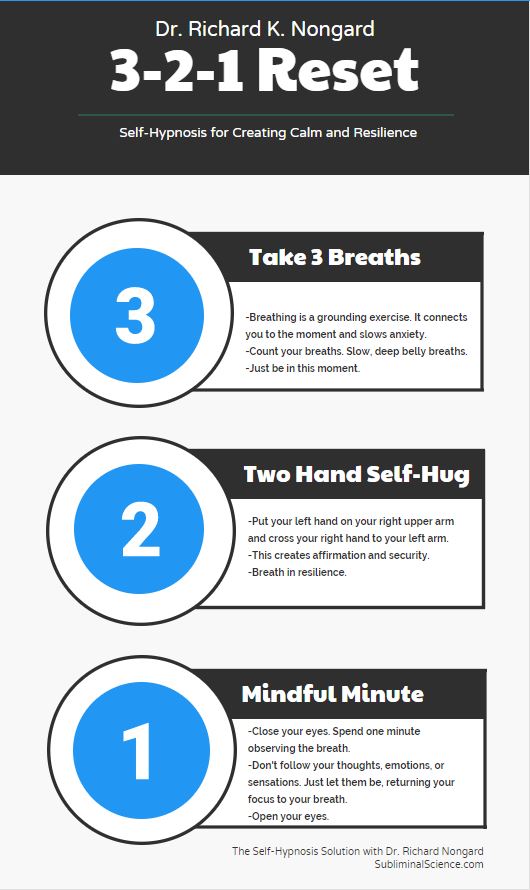Use this strategy to stop anxiety and panic!
It also works with anger, and other emotions that are stopping you from living your best life!
3-2-1 Anxiety Reset (Stop Panic in One Minute!)
3-2-1 Reset Technique: The Easiest Method of Self-Hypnosis
It is called the 3-2-1 Reset Technique because there are three steps.
To begin, find a comfortable place, you can be seated or standing. What is most important is you turn off distractions such as computer windows that might call your attention or turn off the phone or smart watch. The reason this is important is that in self-hypnosis, even a quick process like this, we should become dedicated to it. Distractions are like a tap on the shoulder – we can’t not turn around to see who it is. So it is always best to minimize these even if only for a few moments.
Step One:
As you read these words, simply scan your body and release any obvious tension you are holding onto and pay attention to your breath. As you pay attention to your breath, count the next three breaths. You can do this with the eyes open if you are reading. accessing the resource state of self-hypnosis is not dependent on the eyes being open or closed.
You do not have to breathe in any special way. You can breathe quickly or slowly. You can breathe deeply if you want to, but the most important thing is to just breathe and to count the three breaths. This step is all about grounding and being present in this moment.
Step Two:
take your two hands and cross them across your upper body placing the left hand on the right upper arm, and the left hand on the right upper arm. This is almost a self-hug. It feels pretty good to give yourself a hug and in yoga practices this is advocated because it connects our physical experience to the inner experience. the research actually shows that this self-hug position can trigger physiological responses and release the chemicals in the brain associated with pleasure, security, and well-being.
Some therapists, who practice methods of bilateral stimulation also believe that by crossing the left side to the right side, we ere integrating our thinking and our feeling mental capacities.
Step Three:
Spend the next one minute (three breaths, two hands, one minute) and practice paying attention to the breath. Be an observer of the breath. You can do this with the eyes open or the eyes closed, what is most important is that you allow your breath to be a focal point. Each breath marks each moment. By practicing staying in the present, you are setting aside regrets of the past or fears of the future. During this minute, your mind will continue to think. After all, this is what minds do. Like a fish swims in water, people swim in thoughts. Thinking is perfectly ok. So is being aware of emotions, and so is noting physical sensations.
The practice that you are trying to cultivate during this minute is not stopping your thoughts, emotions or sensations, but rather practicing not following them and using them as a cue to return your attention to the present moment.
You can use a timer, or you can just guesstimate when a minute has passed by. It is also perfectly okay to spend more than a minute focusing on the power of this moment. When you are ready to open the eyes, let a smile come to your face release your self-hug. You can congratulate yourself now. You have just done your first self-hypnosis exercise!

The practice that you are trying to cultivate during this minute is not stopping your thoughts, emotions or sensations, but rather practicing not following them and using them as a cue to return your attention to the present moment.
You can use a timer, or you can just guesstimate when a minute has passed by. It is also perfectly okay to spend more than a minute focusing on the power of this moment. When you are ready to open the eyes, let a smile come to your face release your self-hug. You can congratulate yourself now. You have just done your first self-hypnosis exercise!
This is a very basic process, but one that is highly effective. By adding nothing to his process and simply using it to stop anxiety, practice mindfulness, and relax it will be of value and serve you well for years to come. I have taught this to countless clients, and I have never had anyone exclaim, “OMG Richard! That was amazing! You changed my life! Thank you!” Rather, when I teach this to people they typically have the same response you probably have. They say things like, “Okay, I can see how that is helpful.” Or they say, “That was relaxing.” Or simply, “Ok, I did it.”
I wish that for most of my clients the power of this technique was revealed in the first practice. What happens far more often is that when I tell my clients to practice this twice a day for the next two weeks, they come back with what I call “retrospective excitement.” By practicing it they realize the profound value in it.
Self-hypnosis is a practice. Like a musician who must practice his or her instrument before a debut concert or a comedian who must memorize his scripts and practice his timing to make it appear spontaneous and natural, self-hypnosis requires practice. You will need to be committed to this practice to derive the results, but I promise you the results can be profound.
